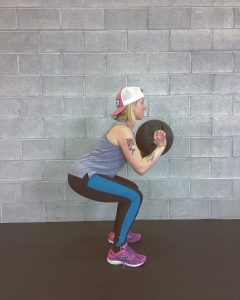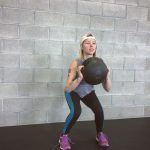Squats seem straightforward but teaching this movement properly with good alignment can be quite challenging. I’ve found this to be true especially with clients who are brand new to fitness. Identifying common errors, knowing how to correct them and progressing a client properly are key components for performing squats effectively.
I’ll be honest, the first times through were a lot of me guessing and checking. Trying to figure out how to verbally and physically cue in a way that made sense, as well as how to effectively strengthen their body outside of the squat movement to prepare for the squat. All of my struggle for your gain, I will lay out what I have found most effective as well as discuss a common alignment myth.
Squat Progressions
My first mistake was not being patient in the progressions. It left me, and unfortunately the client, feeling a bit silly when we tried to move forward only to be thrown back to the previous stage. This is why I believe being patient within the progression process is one of the most important aspects of teaching a squat to a beginner. You don’t want to advance a client too quickly and have them feeling discouraged when they just cannot attain the next movement, thus needing to move back to where they were.
Squat Progression Sequence:
- Squat and Sit – Use a plyo box or bench that reaches to knee height on the client. Have the back of the client’s heels placed 4-5” away from the box. Instruct them to sit down and stand up without any assistance of the hands. If they cannot control the movement during the entire descent, and fall to the seat, choose a box/bench that reaches a few inches above the knee joint. Advance them once this movement becomes efficient.
- Stability Ball Wall Squat – Even though this one is classified as a squat progression, the movement is very similar to a wall sit. However, that is why it is a great progression move for squats. The weight stays over the pelvis, requiring true activation of the external rotators and quadriceps. The client will pin a stability ball between their sacrum region and a wall.Slightly leaning the body into the ball with the feet ahead of them, instruct the client to maintain neutral spine as they lower the hips straight down. The movement should be smooth and controlled, with the knees at a 90-degree angle and lining over the ankles at the end motion.
- Assisted Body Weight Squat – Using a TRX have the client hold a strap in each hand, weight over feet, elbows flexed and under shoulders. You want tension in the straps. Que them to squat allowing the elbows to extend in front of them. Be sure they have correct form here because this is when they start learning how to support and distribute their weight and balance. If it is incorrect here, it is very challenging for them to have correct alignment without support. Once they can perform 3 sets of 10 with only their pointer finger on the straps, they are ready to move forward.
- Body Weight Squat – Depending on the client, you shouldn’t need to spend too much time in this portion. Body weight squats are always a great exercise, however in the theme of progressing it is a stepping stone to loaded squats. Once the client can effectively, and in proper alignment, perform 3 sets of 10 they are ready to start adding some weight to their squat!

- Goblet Squats and Front Squats – I combine these two exercises because they can be happening within the same time period of progression. Holding weight in front will shift a client’s center of gravity forward. This allows them to really sit back in the decent, training the proper activation and recruitment of the glutes and thighs. This also starts to bring more of the upper body into play.
- Back Squat – Woohoo, you have arrived at the infamous back squat. By this point, if adequate time has been spent in each period of progression, the client should be physically conditioned to practice this exercise safely and effectively.
Common Squat Errors and Corrections
Another big challenge I experienced was transmitting information to my clients in a way that they understood. As a trainer, I would understand if someone told me to “brace my core” or “engage my external rotators”. However, most clients are brand new to the fitness world. They are still building their motor skills and body awareness. I’m going to list some of the common squat errors I have run into, and how I effectively queued my clients.
Caving Knees

Caving Knees
We all know this one, and it never fails to generate the internal wince. This is usually due to the client not understanding how they are supposed to use their external rotators and hip abductors; not necessarily because these muscles are weak. Luckily, this is a pretty quick fix.
First, I will try queuing the client to ground through their big toes, drive knees wide and keep feet firmly planted. For some clients, this is all that’s needed. They will feel the correction and understand what was originally wrong. However, some clients will continue to have the knees wobble in and out during the movement.

Correction for Caving Knees
I have the client put a looped resistance band around the legs, and just above the knees. I like to use the cloth Sling Shot brand, they are wide and soft, making it easier to bring around the thighs. With the band in place, I instruct the client to squat while pressing their thighs against the band.
With the particular resistance band I use, it would take hulk like strength to push too much that the knees bow out. However, depending on your band’s resistance strength, you can instruct them to lightly but firmly press into the band. This will give them just enough physical queuing to bring their knees in proper alignment.
Knee Valgus
Another common error within the squatting motion is an excessive forward translation of the knees and shins. This can be due to limited ankle mobility, weakness in hip abductors and/or external rotators, often times being the Gluteus Medius.
However, the usual culprit is that the client is trying to initiate the squat motion with knee flexion rather than hip flexion. Try queuing the client to hinge at the hips first, sending their weight back as if they were trying to sit down, then allowing the knees to bend. It is also helpful to return the client to the front squat. As I said before, holding weight in front changes the center of gravity allowing them to more easily sit back in the decent.
If they are still struggling to shift their weight back it might be necessary to spend some time teaching them proper pelvis hinging mechanics.
If it is due to weakness, a good exercise for this is the Glute Bridge with a looped resistance band around the thighs. This will help teach the body how to flex and extend the hips without knee valgus. There is also leg and hip abduction exercises that would be great for strengthening the needed musculature.
For clients that I know have adequate strength and mobility to perform a proper squat, but are just struggling with the coordination and timing, I like to use a wall for assistance. I have the client face a wall with their toes 1-2” away. With their hands on their hips, instruct the client to squat without touching their knees or face to the wall. It will feel awkward and almost impossible in the first few tries, however, encourage them to keep trying and soon they will feel how they need to recruit their muscles.
Depth Control
It seems redundant to say, but it is still important to cover. Each client is different! Each client will have a different depth within their squat. What used to be the general rule of thumb is thighs parallel to the ground and knees never go past the toes. This still holds validity, especially for group instructors who want to give out instructions to a large group of people. However, when working with clients one on one, this aspect can be tailored. The squat might be shallower or deeper depending on their personal ROM, strength, and mobility.
The Knee Over Toe Alignment Myth
The knee over the toe myth is just that, a myth. I believe it should be something more like “Knees should not excessively pass over the toes” as in knee valgus. This is a great starting point for your beginner clients who are still learning their coordination and strength within the squat.
Yet, as the clients progress and become stronger, they will be able to squat deeper. When a squat becomes deeper than the thighs parallel to the ground, the knees will translate forward. If a client were to try and keep the knees behind the toe line in deeper squats, it would result in them either falling backward or using improper technique and consequently be placing excessive load on the low back and hips. As long as a client has been correctly taught how to squat, some forward translation of the knees is okay!
Be patient within progressions, understand your clients’ personal capabilities and you will have them squatting like the pros in no time!
If you have a client who is ready for some new variations check out the Rear Foot Elevated Split Squat.
Alex has her A.S in Exercise Science and is a certified Personal Trainer with NFPT and NSCF. She recently traveled to India to gain her 200 hr yoga teacher certification where she studied the ancient practice at its origins. Alex has spent time teaching yoga in Spain while volunteering at a yoga retreat and is currently working at her local college instructing two fitness courses. Alex wants to share with her clients and students the mental, physical and emotionally healing qualities of exercise and movement. She believes everyone should have a healthy relationship with their bodies and strives to thread that concept throughout her career.

